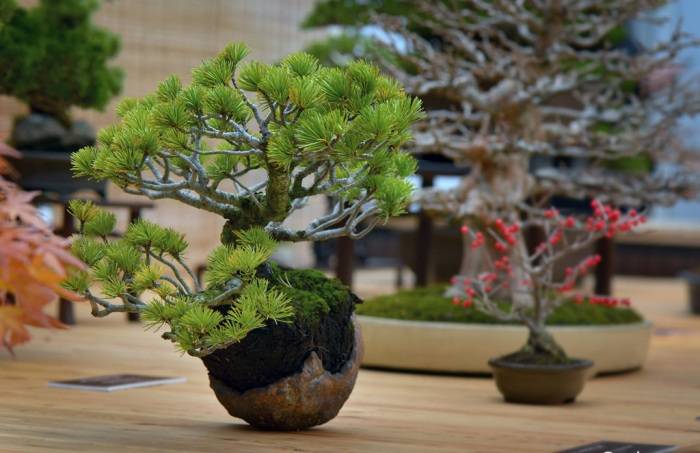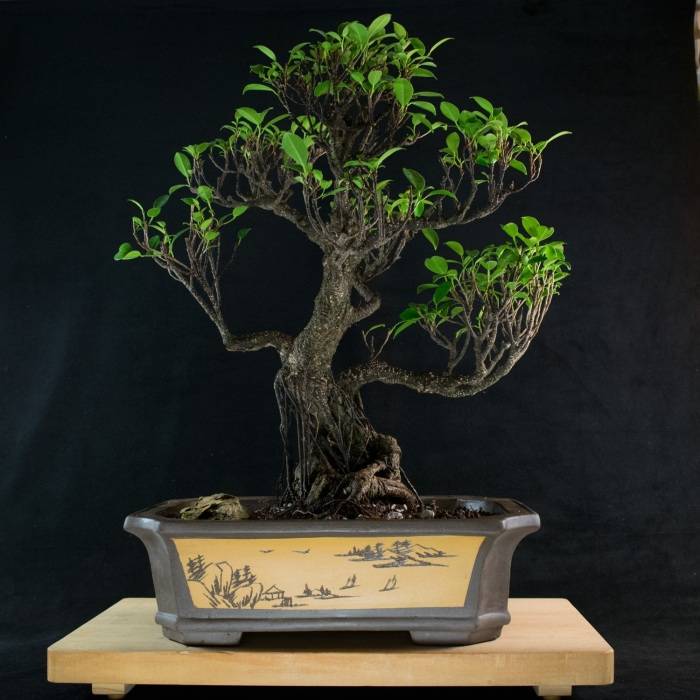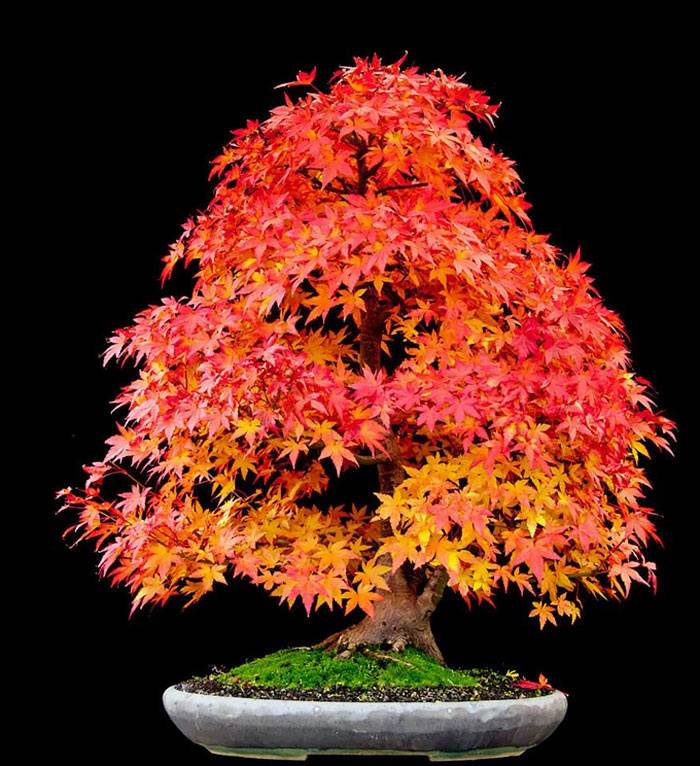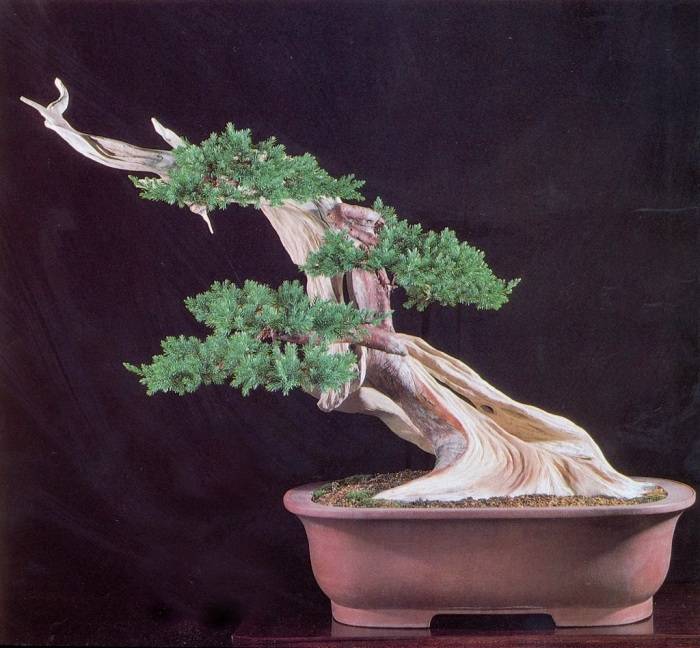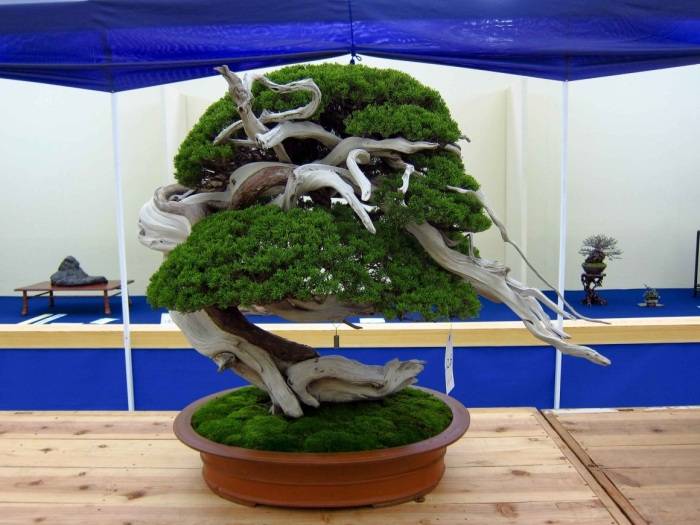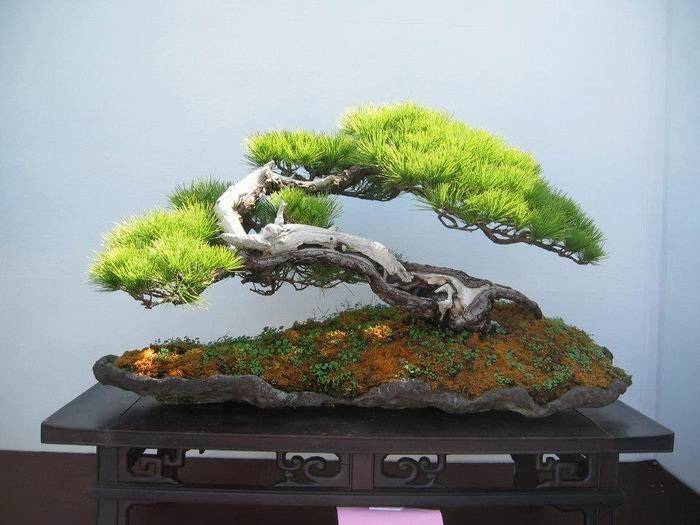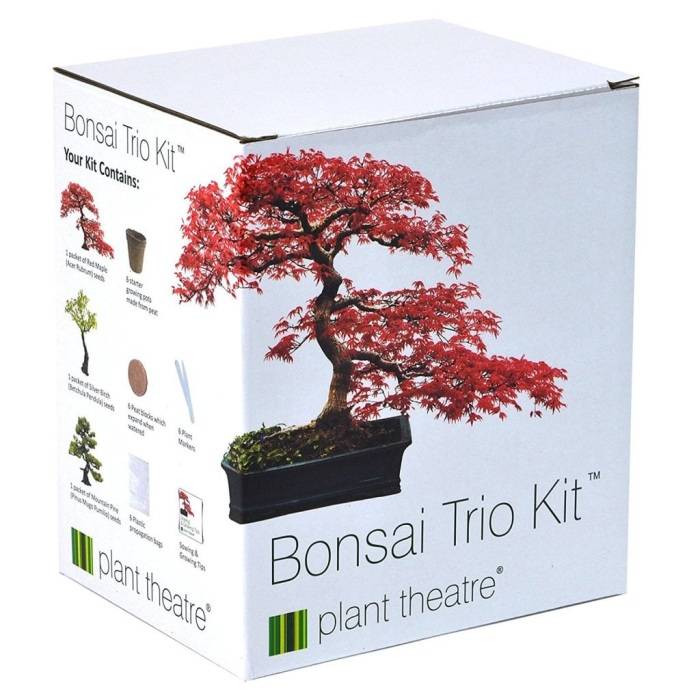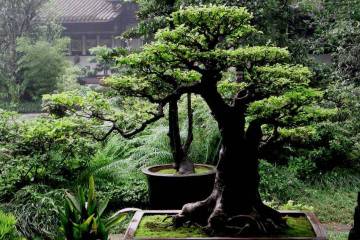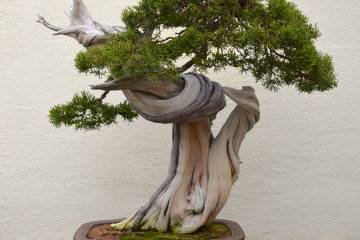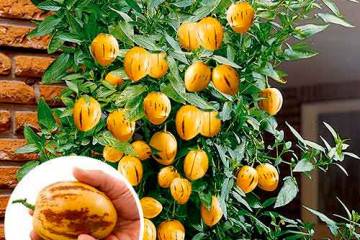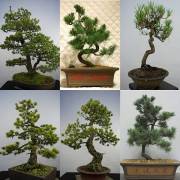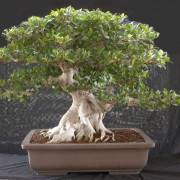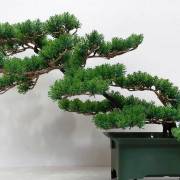Bonsai tree - history and classification
Content:
The Eastern culture of creating miniature bonsai trees is gaining more and more popularity. Bonsai art is a whole philosophy, knowledge of the world through small copies of plants. Tiny trees in pots and on trays are a symbol of the Land of the Rising Sun. The history of bonsai, styles, sizes, tools needed and growing methods will be discussed below.
History of art
Bonsai in Japanese means "tree in a bowl" (or "tree on a tray"). Many people want to know how to spell it correctly: bonsai or bansai. The correct spelling is through "o".
The art of making shrunken trees was born in China (contrary to popular belief that it happened in Japan). When this happened, it is not known for certain. Some researchers are inclined to believe that this happened 2000 years ago, others - that 1300. It is known for sure that by 706 AD. this art has already been developed in China. It is this year that images of dwarf trees found in 1972 are dated.
In Chinese, growing smaller copies of trees is called penhai or penjing (or, in other provinces, pingching, penjing). In the Celestial Empire, dwarf plants had a purely decorative value, they were not endowed with any sacred meaning, as later in Japan.
Legends associate the emergence of the Penjing with the desire of the emperor of the Celestial Empire (Han dynasty, 206-220) to create a symbolic copy of his state. It was supposed to be located on a marble platform in front of the imperial palace. Here they recreated natural landscapes, cities, people and even animals living in the vastness of the Chinese empire. Skilled gardeners have created small copies of trees growing in the Middle Kingdom.
According to another legend, the poor, forced to move to Chinese cities, longed for the nature of their homes. They began to grow dwarf plants on trays and in porcelain containers, which grew in their homeland.
Subsequently, this fashion spread among the Chinese nobility. Small trees served as decoration for rich houses and were intended to symbolize the wealth of the owner. They began to grow not just single plants, but entire gardens on one tray.
The third Chinese legend about the origin of the Pensai is associated with the adoption of Buddhism at the beginning of the first millennium AD (approximately 60 years). Buddha Shakyamuni (Gautama Siddhartha) meditated and conducted dialogues with his novices under ficuses (Bodhi trees), which became considered sacred plants in Buddhism.
As in many religions, it is customary in Buddhism to make pilgrimages to places of power. The Chinese nobility was too lazy to go to the sacred grove of Bodhi trees, so ficuses began to be grown in gardens. But this was not enough. Fashionable in China "Golden Lilies", distorted female legs, did not even allow them to go out into the garden. So the gardeners of the wealthy Chinese found a way out. They began to grow special small ficuses in pots and carried them to noble Chinese women, who could not move on their own, to the house to perform prayers.
Bonsai was brought to Japan by Buddhist monks, approximately in the 30s.XIV century. The first Japanese bonsai trees are ficuses, pines, birches.
Initially, only high-ranking officials and Buddhist clergy were the owners of dwarf plants. Only in the 18th century. they became available to ordinary Japanese as well.
Bonsai cultivation technology improved from the 17th to the 19th centuries. The creators of these miniature plants began to organize exhibitions. The division of pinchins into species appeared, and various cultivation styles began to be applied.
From Japan to Europe
Bonsai was brought to Europe only at the end of the 19th century. In 1889, at an exhibition in Paris, various specimens of pinchins were presented. 20 years later, the presentation of works of this art took place in London.
At first, this type of decorative botanical art was perceived with hostility as a mockery of living plants. The situation began to change only after the Second World War.
Plant symbolism
What is bonsai to Japanese? It is a sacred tree of life, a miniature Buddha garden. The owner of the pinchin feels like a gardener, a powerful ruler of his corner of paradise, who has approached God.
According to the culture of organizing the space of Feng Shui, different types of pinchins will mean different benefits for their owner:
- Bonsai maple brings good luck, sociability to the owner's life, takes all the negativity on itself, softens conflicts, brings peace to the house. It is better to put it in the living room.
- Bonsai birch soothes the nerves, eases the suffering of unrequited love. It is good to place it in the bedroom.
- Bonsai oak, especially if it has at least one acorn, gives the male owner success and recognition, but is not suitable for a woman. The best place for him is his study.
- Bonsai lotus is the focus of tenderness and beauty, it gives enlightenment to its owner.
Bonsai sizes
Pinchins are both small, 3-5 cm high, and very large, up to one and a half meters.
The care of plants of different sizes is slightly different, for example, small ones need to be replanted annually.
For mini-bonsai, those plants are used that do not reach large sizes in nature:
- Chinese elm;
- boxwood;
- myrtle;
- buckthorn;
- rosemary;
- cypress;
- dwarf bamboo.
Two methods are used to determine the height, depending on the type of bonsai:
- measured from the point where the roots emerge from the trunk to the highest point of the crown;
- measurement from the edge of the pot or pallet.
Bonsai styles
The styles of Japanese bonsai are traditional (classical) and special. For the classic, a number of canons for planting, shaping and care are provided. But such rules also allow deviation from them. There are no such rules for specific styles.
Traditional
These include:
- Hokidachi, with a straight trunk and a diverging crown, reminiscent of a broom.
- Chokkan, with a straight trunk, evenly tapering towards the top, similar to the mast of a sailing ship.
- Shakan, depicting a curved tree, clinging to life with all its might, constantly opposing the elements.
- Moyogi, where the barrel bends upward in a spiral.
- Kengai, which resembles ampelous (hanging from pots) plants.
- Ikadabuki when the tree must grow horizontally.
Special
- Natsuranari, when several trunks extend from one root.
- Fukinagashi, where the plant is curved like a storm wind on a cliff.
- Yose-Ue, where there is a main tree and a whole group of smaller ones.
- Saykei, where there are several different plants, soil, interesting stones, i.e. landscape in miniature. This style is closer to Chinese culture than Japanese.
More specifically about the techniques
A novice bonsaist needs to be well prepared and have patience. Growing a bonsai tree is a step-by-step process. First, you need to decide on the style of the future bonsai in order to select the right plant and the necessary tools. Chokkan style is suitable for beginners (pine, maple, ash, apple, they are less capricious). The styles of ball and sabamiki are quite complex.
Sharimiki
These are plants with patches of dead wood. Most often, a juniper growing in nature on mountain slopes is used for this. Fragments of the bark of this plant fade to whiteness in the sun. There are also areas that are generally not covered with bark. In bonsai, parts of the plant are artificially removed.
Sabamiki
Trees, whose trunk is artificially split into two parts, as if they were struck by lightning. How to grow a bonsai of this shape? In the sabamiki technique, large plants are used, at least 70 cm in height. The trunk is divided with special nippers. Expand the split with wedges.
Tools for shaping work
Bonsaist will need:
- Sharp scissors.
- Concave nippers for cutting branches and bark.
- Wire to create the desired shape of the trunk and branches.
- Convex pliers for creating fast-closing cavities and removing growths on the trunk and roots.
- Sushi sticks, the main purpose of which is to untangle roots and remove excess soil. Special hooks are also sold for this purpose.
- Japanese saw for removing excess branches and decorative notches.
- Shovels and tools for sifting the soil (special frames like a sieve with interchangeable screens, where the mesh size is different).
- Ashinaga Basami scissors used for crown thinning.
- Soil aeration rakes.
- Branch bender.
Size classification
There are:
- keshi-tsubo (from 3 to 5 cm);
- sieve (from 6 to 10 cm);
- sokhin (10-15 cm);
- mame (15-20 cm);
- komono (20-25 cm);
- katade-mochi (25-45 cm);
- chiu (46-91 cm);
- omono (80-122 cm);
- hachi-ue (122-152 cm);
- imperial (150-203 cm).
Agrotechnics
It involves choosing a location, finding sources of planting material, or buying a finished bonsai.
Before growing a bonsai at home, you need to think about where to put it.
The choice of location depends on the needs of the particular plant. From the point of view of the philosophy of Buddhism, pinchins need a separate place (table or cabinet), where only a mini-tree and a stone of a beautiful natural form will stand.
Some plants cannot be placed indoors. They will need a place in the garden.
Sources of planting material are very different: seeds, cuttings, ready-made trees.
Dwarf bamboo, Benjamin's ficus, pomegranate, Bougainvillea are suitable for growing at home.
Currently, you can buy ready-made bonsai. But you still have to learn the intricacies of caring for him, otherwise the pinchin will die in a few days.
As a material, you can use trees growing in the wild, especially in swamps, mountain slopes and other unfavorable places. There you can find already formed living miniature plants. They did not receive enough food, they were tormented by bad weather, so they will not have a headache, how to make a bonsai. After all, he is already ready.
As a planting material, you can cut stem or root cuttings. Shoots are chosen green, flexible, 5-15 cm, with several internodes, so that it is convenient to plant. Coniferous trees are cut in early spring or from mid-summer, deciduous trees - from the last decade of May to early July.
How to grow bonsai at home
Mise
The seeds are collected from trees growing in the wild.Several seeds are planted in one container. The seed takes a long time to germinate. Choose one, the strongest sprout.
Toriki
This technique allows you to grow pinchins from cuttings or cuttings.
Yamadori
In nature, they find a suitable young specimen, make a ditch, exposing the tips of the roots. In a couple of months, aerial roots will form on the bare areas and the plant can be taken away. Bonsai technique is so easy that it is suitable for beginners too.
Weki
Buying a ready-made plant and shaping it according to your preferences.
How long does a bonsai tree grow from seeds? At least 12-15 years old, depending on the type of plant.
Bonsai tree wintering
Trees growing in the subtropics and the middle lane need a dormant period.
To organize this you need:
- from August, the amount of fertilizer applied and watering is reduced (while not allowing the earthen coma to dry out completely);
- do not carry out pruning since the beginning of autumn;
- do not protect plants from a moderate drop in temperature (minimum temperature is minus 4 degrees, at lower temperatures, you need to hide the plant in a shelter).
Basic set for growing bonsai
Specialized stores offer ready-made sets for growing pinchins. This includes the tree itself, wire, container and soil.
Often, instructions on how to plant a bonsai are presented along with the kit. The rest of the tools are sold separately.
Whichever way to acquire a "tree on a tray" would be chosen, it will always become a wonderful interior decoration and will give the owner a lot of pleasant minutes from contemplation. Of course, it is difficult to say that this art is easy and suitable for beginner plant lovers. But on the other hand, it is definitely interesting, and the result obtained will more than cover all efforts.
